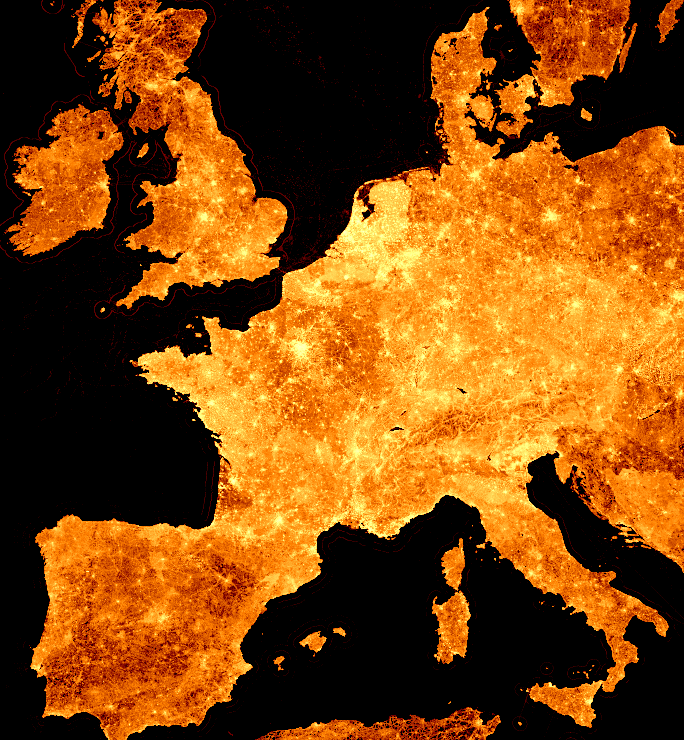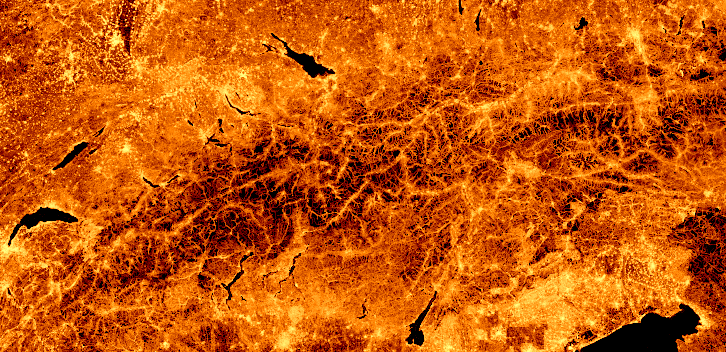Exactly one year ago I published my first visualization of the global OpenStreetMap data density. This is the updated 2014 edition.
 (click image for slippy map or here for high-res images)
(click image for slippy map or here for high-res images)
Each pixel shows the number of nodes in its corresponding area¹. But this year every point that has data in it is shown (i.e. there is at least one node at that location - last year only locations with more than 1000 nodes were included). Also, the slippy map has two more zoom levels which reveal even more impressive details like on this crop of the central Alps:

Here is a low-zoom image of the whole planet:

¹ Yes, this is Mercator map tile area, not actual on-the-ground area. Keep this in mind when comparing regions at different latitudes!
² Copying: visualizations © Martin Raifer, CC-BY - source data © OpenStreetMap contributors, ODbL
PS: The visualizations are based on a planet file I downloaded one or two weeks ago. It was processed using some custom scripts based on node-osmium, the graphics were made with gnuplot (just like last years’) and finally the map tiles for the slippy map were cut using imagemagick. I could probably explain the individual steps in a separate blog post, if anyone was interested - let me know!

討論
由imagico於2014年6月27日11:15發表的評論
Very nice. Maybe you could publish the color scales for the different zoom levels, i.e. what color represents how many nodes per web mercator square kilometers.
Converting the data to real densities should be relatively easy by multiplying with the area scaling function of the projection. This would lighten up the polar regions quite a bit, Greenland for example is is fact mapped with similar node density in the north and south.
由Endres Pelka於2014年6月27日14:14發表的評論
Yes, please publish the individual steps. I’d like to render a similar map, but only for some smaller regions and with higher zoom levels :)
由HannesHH於2014年6月28日10:27發表的評論
That’s gorgeous! I want that Europe image framed on my wall. :)
由marscot於2014年6月28日11:12發表的評論
that is a great picture
由grin於2014年6月28日16:45發表的評論
Beautiful, thank you very much!
由AnnaPS於2014年6月28日18:04發表的評論
This is gorgeous. I’d love to see a blogpost with the individual steps!
由Noro Hibu於2014年8月12日07:15發表的評論
I am interested. Please tell in detail how you did it)
由stev於2015年2月15日17:57發表的評論
Hi,
I’m writing a thesis on whether Hadoop / other “big data” tools might be useful to analyse OSM data (https://lists.openstreetmap.org/pipermail/dev/2015-January/028227.html) so this is the sort of operation that it would be great to compare. If you have any further details about how you did it I would be much obliged.
Thanks
Stephen
由Enock4seth於2015年4月29日20:05發表的評論
Awesome! I like it.
由goclem於2017年2月9日09:39發表的評論
Thanks a lot for this map! I was wondering what was the maximum number of nodes in one pixel of your map. I understand that the minimum is 1000. Best, Clément
由tyr_asd於2017年2月9日10:01發表的評論
@goclem: In this visualization (as well as the updated one) from 2016, there is no minimum number of nodes in a pixel. The maximum depends very much on the zoom level you’re looking at. Frederic’s analysis from 2013 may give you some more insight into what absolute numbers one might have to expect.